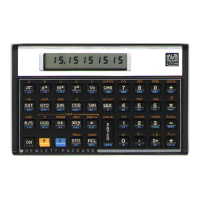SectionS:
Calculating
in
Complex
Mode
73
Using
|
SOLVE
| and
|/?|
in
Complex
Mode
The
|
SOLVE
| and
[7T|
functions
use
algorithms
that
sample your
function
at
values along
the
real axis.
In
Complex mode,
the
|
SOLVE
| and
[W\s operate with only
the
real stack, even
though your
function
subroutine
may
have complex computations
in
it.
For
example,
|
SOLVE
|
will
not
search
for the
roots
of a
complex
function,
but
rather will sample
the
function
on the
real
axis
and
search
for a
zero
of the
function's real part. Similarly,
[7T|
computes
the
integral
of the
function's real part along
an
interval
on the
real
axis. These operations
are
useful
in
various applications, such
as
calculating contour integrals
and
complex potentials.
(Refer
to
Applications
at the end
of
this
section.)
Accuracy
in
Complex Mode
Because
complex numbers have both real components
and
imaginary components,
the
accuracy
of
complex calculations takes
on
another dimension compared
to
real-valued calculations.
When
dealing with real numbers,
an
approximation
Xis
close
to x
if
the
relative
difference
E(X,x)
=
\(X
—
x)/x\s small.
This
relates
directly
to the
number
of
correct significant digits
of the
approximation
X.
That
is, if
E(X,x)
< 5 X
10"",
then there
are at
least
n
significant digits.
For
complex numbers,
define
E(Z,z)
=
\(Z
—
z)/z\
This
does
not
relate directly
to the
number
of
correct
digits
in
each component
of
Z,
however.
For
example,
if
E(X,x)
and E(
Y,y)
are
both small, then
for z =
x
+ iy,
E(Z,z) must also
be
small.
That
is, if
E(X,x)
< s and
E(
Y,y)
< s,
then E(Z,z)
< s. But
consider
z =
1010
+ i and Z =
1010.
The
imaginary component
of Z is far
from
accurate,
and yet
E(Z,z)
<
10"10.
Even though
the
imaginary components
of z and Z
are
completely
different,
in a
relative sense
z and Z are
extremely
close.
There
is a
simple, geometric interpretation
of the
complex relative
error.
Any
approximation
Z
of
z
satisfies E(Z,z)
< s
(where
s is a
positive real number)
if and
only
if Z
lies inside
the
circle
of
radius
s\z\d
at 2 in the
complex plane.

